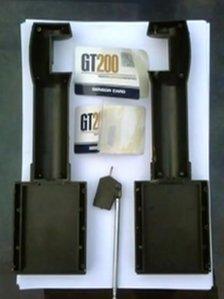Businessman Gary Bolton 'sold fake bomb detectors'
- Published

Gary Bolton has denied two charges of fraud
A businessman created a company with a £3m annual turnover selling homemade bomb detectors that did not work, a court has heard.
The devices made by Gary Bolton, 47, at his Kent home and company offices, were nothing more than boxes with handles and antennae, the Old Bailey was told.
Yet he sold them for up to £10,000 each, claiming they could detect explosives, the prosecution allege.
Mr Bolton, of Redshank Road, Chatham, Kent, denies two charges of fraud.
Richard Whittam QC, prosecuting, told the court Mr Bolton knew the devices - which were also alleged to be able to detect drugs, tobacco, ivory and cash - did not work but supplied them anyway to be sold to overseas businesses.
He said one company had x-rayed the device and found nothing inside the box.
Mr Whittam said tests on the detectors, carried out as far back as 2001, had suggested they performed no better than random searches for explosives.
"And despite the fact that the prosecution alleges that they do not work... people did buy them, and he could get that (£3m) turnover, and his company could make a considerable amount of money," he told the court.
'No functioning parts'

X-rays on the GT200 showed the box to be empty
The prosecutor said Mr Bolton, who ran a company called Global Technical Ltd, had admitted to officers from the City of London Police that he had made the devices at home and at the company's offices near Ashford, where component parts for the equipment - marketed as the GT200 - had been found.
Mr Bolton had claimed the devices worked with a range of 756 yards (700m) at ground level and up to 2.5 miles (4km) in the air, the court was told.
Tests on the device in 2001 showed it had a successful detection rate of 9%, and the results of the test had been sent to Mr Bolton, the jury heard.
In 2010, a Home Office defence expert found the device had "no credibility as an explosive detector" because it had no functioning parts.
Further tests carried out by Dr Michael Sutherland from the University of Cambridge found that the device worked successfully twice in 24 tests when searching for TNT, which was less than the probability of finding the explosives at random, the court heard.
Dr Sutherland said the device was "completely ineffectual as a piece of detection equipment".
"The operating principle of the GT200 device lacks any grounding in science and I cannot see how it can work in accordance to the known laws of physics," he wrote.
"Carefully executed field trials of the device showed that it offered no advantage in detecting explosives over random chance."
Nothing in the box

The GT200s were manufactured at premises near Ashford
The jurors were told by Mr Whittam they would have to decide whether Mr Bolton had falsified reports to show the effectiveness of the devices.
In 1999 Mr Bolton approached the Royal Engineers Exports Support Team (Reest) and asked them to produce a report on a detector called the Mole.
They found that it was accurate only about 30% of the time and could not be relied on.
Two "letters of recommendation" from Reest and dated June 2003 were found at Mr Bolton's officers, the court heard.
They referred to the GT200 model which went on sale in 2004 and which the engineers had never tested.
In 2004, Mr Bolton sold a device to British American Tobacco for £11,000.
The company found it to be ineffective and x-rayed the device only to find there was nothing inside the box.
Mr Whittam told the jury: "You will have to consider whether Mr Bolton continued to promote it despite receiving several reports saying it was unreliable and ineffective."
The trial continues.
This story was amended on 20 August to reflect the fact the name of Gary Bolton's company was reported in error as Global Technology Limited, which is not connected in any way to the defendant's company, Global Technical Ltd.
- Published2 July 2013